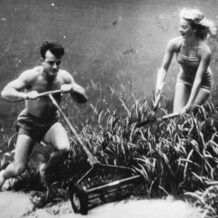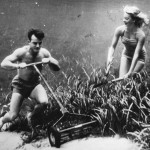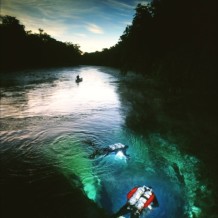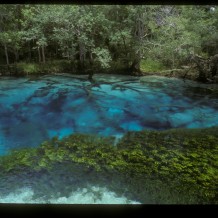caring for your spring
Ginnie Springs
There are over 700,000 people in the entire Santa Fe River springshed, which includes Ginnie Springs. The water from Ginnie Springs and the surrounding springs supplies us with clean drinking water, recreation opportunities, and so much more, in addition to providing key habitats for fishes and aquatic animals. There are no other alternative surface water supplies to support the large population in the surrounding areas, and the rate at which we are using the water in the springshed (about 181 million gallons per day) is not sustainable – so we must all care for our springs so that we may continue to benefit from their resources.
All of us can play an instrumental part in the recovery of our springs, whether it is through simple daily acts, taking action to demand that our government and water management districts make smart water decisions, or as part of a group. Here are some ideas:
a. Simple daily changes:
The two main things to keep in mind are that we need to use less water and reduce the amount of nitrogen entering the aquifer. Here are some things we can do right now:
- Trade water-intensive lawns for native vegetation that requires little watering and no fertilizer. If Jacksonville and Gainesville stopped watering lawns, we would draw about 60 mgd (million gallons per day) less from the baseflow (aka springflow) of the Suwannee River and its tributaries as a whole and significantly reduce the percentage of water being drawn from the aquifer in the Ginnie springshed. Wherever we live, we can make a crucial positive impact by not watering or fertilizing lawns.
- Take shorter showers (<5 minutes)
- Install low-flow showerheads and toilets
- If you have a septic tank, have it inspected regularly
- Find out more about your own daily water use here: National Geographic Water Footprint Calculator.
- Think about your daily water habits, including food and shopping choices. If you don’t do so already, consider eating local and organic, and buying goods and services from local businesses whenever possible.
- Find out how much water it takes to make a pound of beef compared to chicken or apples; biomass energy or wind energy; wheat, wine and a lot more products. See National Geographic’s Hidden Water Use page.
- Please see the Alachua County DEP handout for more suggestions.
b. What we can do as responsible and concerned citizens:
We can insist on prudent and responsible water management. Specifically, we can call on the Florida DEP and our Florida Water Management Districts to provide better water management that keeps our springs and aquifer healthy and flowing. Here are some points, below.
The kind of prudent and responsible water management we need in order to restore the health and flow of our springs and aquifer cannot occur without an accurate picture-including accurate numbers- that tells us how much water is being used by whom, when and for what purposes.
Call for water quality and quantity planning that:
- relies on the most accurate aquifer model available. Currently state officials use computer models that do not reflect the reality of how water moves through the karst system. However, there is a far better karst-based computer model available, one already developed, tested and implemented in the Santa Fe springshed by Dr. Todd Kincaid. By taking the hydrogeology of the karst system into account, Dr. Kincaid’s model can more accurately assess how-and how quickly-water travels through the system, which gives crucial information about the impact of groundwater withdrawals on the aquifer. This information is important for calculating recharge, pollution and the potential development of sinkholes, and should be a primary source of data whenever WMDs consider issuing permits for water withdrawals. Please see Craig Pittman’s “Florida’s aquifer models full of holes, allowing more water permits and pollution,” published in the Tampa Bay Times on Sunday, January 27th, 2013. You can also see a pdf of Dr. Todd Kincaid’s groundwater model, (large file, takes a while to download) a better solution to the current model. Water quality and supply is fundamental to our well being Let’s require our WMDs and DEP to adopt the more accurate karst-based model and demand that our Florida legislators apportion our tax dollars to properly fund it. We also must fund independent science, such as the Howard T. Odum Florida Springs Institute. FSI is directed by Dr. Robert Knight, a leader in Florida springs research for thirty years.
-
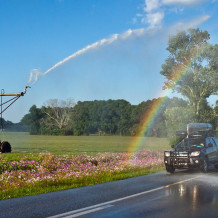 In many springsheds, large scale agricultural operations are the largest users of water and distributors of nitrogen fertilizers. Center pivot irrigation systems are inefficient, with much water lost through evaporation and poor placement. Along with leaky septic systems and too much animal manure, these agricultural practices contribute to depleting our aquifer, increasing nitrate nitrogen levels above legal health limits, and lead to algae choking our springs. Given the highly porous nature of our karst system, there is no right place in vulnerable springsheds for crops – or lawns – that require nitrogen fertilizers. Photo by John Moran
In many springsheds, large scale agricultural operations are the largest users of water and distributors of nitrogen fertilizers. Center pivot irrigation systems are inefficient, with much water lost through evaporation and poor placement. Along with leaky septic systems and too much animal manure, these agricultural practices contribute to depleting our aquifer, increasing nitrate nitrogen levels above legal health limits, and lead to algae choking our springs. Given the highly porous nature of our karst system, there is no right place in vulnerable springsheds for crops – or lawns – that require nitrogen fertilizers. Photo by John Moran
- requires mandatory metering of all water users, especially large-scale agricultural operations presently exempt, so we can begin to develop an accurate picture of know how much water is actually being withdrawn from the aquifer by whom, when and for what purposes.
- reduces groundwater pumping to restore spring and river flows. This can begin by placing a moratorium on issuing new consumptive use permits (CUPs) until an accurate groundwater model is implemented, one agreed to by the public and independent scientists. Then establish Minimum Flows and Levels (MFLs) that insure enough water is left in the system to maintain healthy natural springs, rivers and wetlands ecosystems. In terms of Ginnie Springs, the SRWMD is currently setting MFLs and have been working on them for 4 years – it is not certain when they will be set. What is important is that we set MFLs that are actually protective; the 35% reduction in flows that we’ve already seen since the 1970s means that we are not protecting the resource at our current rate of consumption.
- reduces the amount of nitrogen and phosphorus leaching into the aquifer. Begin by following the lead of other aquifer-sensitive regions that place a limit on fertilizer use, improve wastewater treatment and disposal practices, and relocate land use practices that are unsuitable for the area. Due to the highly vulnerable karstic nature of the Ginnie Springshed, there is really no right place for crops that require nitrogen fertilizers. Realistically, we need to reduce the nitrogen fertilizer applied by >50% in the entire Santa Fe springs basin. This would require everybody – both residential and agricultural sources – to reduce the amount of fertilizers they use. Clearly, the first step should be to eliminate the use of nitrogen fertilizers for lawns and landscaping. The remaining reduction will need to be equitably spread over the agricultural landscape.
c. Stay informed:
See “Resources” and join the Springs Eternal Project facebook page.
Under “Groups, Research, Education and Public Policy,” you’ll find a link to the Howard T. Odum Florida Springs Institute, a leader in springs research, and their springs resources pages; listings for blogs written by Sonny Vergara and Tom Swihart, two retired Florida water management officials who continue to track public water policy and management in the state; a link to the Florida Conservation Coalition (FCC), a bipartisan group offering legislative updates on conservation issues, including water policy; links to Craig Pittman’s series in the Tampa Bay Times: “Florida’s Vanishing Springs”; and a link to the Florida Clean Water Network, which offers legislative updates and action alerts on water quality issues.
Under “Art, Literature, Film and Culture,” you can find key sources covering Florida springs and water history, ethics and public policy, including award-winning journalist Cynthia Barnett’s Mirage: Florida and the Vanishing Water of the Eastern U.S. (2007) and Blue Revolution: Unmaking America’s Water Crisis (2011). Margaret Ross Tolbert’s Aquiferious (2010) offers poetic, aesthetic and scientific views of twelve North Florida springs, including Ginnie.
Join the AQUIFERious Facebook group for current discussions about springs issues.
d. Ways you can help as part of a group:
When we work together, we can amplify our efforts to protect the springs we love. You can attend the board meetings of local municipalities, counties, and water management districts to stay involved with the policies that affect our water.
There are several groups you may want to consider joining or getting on their email distribution lists. Here are a few:
Our Santa Fe River
Giving our river a voice, Our Santa Fe River is a citizen based non-profit working to protect the waters and lands that support the aquifer, springs, and rivers within the watershed of the Santa Fe River.
Santa Fe River Springs Basin Working Group
A great place to learn more about our local springs and to network with others working to protect springs is at the Santa Fe River Springs Basin Working Group. Everyone is welcome to attend the quarterly meetings and to learn from the presentations from local professionals, researchers, and activists. To find out when the next meeting is, visit this link.
Save Our Suwannee
To find out more about water quality problems and solutions in the Suwannee River watershed, click here.
Current Problems
Current Problems is a grass-roots non-profit founded in 1993 with the mission to preserve and protect North Florida’s waterways for humans and wildlife through action, education, and awareness. Current Problems is best known for its many waterway cleanups, having removed more than 330 tons of trash over the years. The group also occasionally conducts shoreline revegetation and stormwater pond planting projects.
Become a member of the Howard T. Odum Florida Springs Institute!
The Florida Springs Institute (FSI) is dedicated to supporting springs science and the education necessary for restoration and wise management. Their website offers a wealth of resources on Florida’s water quality and quantity, including news and Dr. Robert Knight’s studies, papers, and springs restoration plans.
Visit their website and support our springs by becoming a member today! Your membership fee will be used to help further the efforts of springs research and education. You will also receive a quarterly newsletter and email updates about our shared springs resources and get discounted attendance fees for FSI-hosted events, workshops & receptions.
Additionally, FSI recently convened the 2013 Springs Conservation Summit, which brought together 15 water stakeholders from a wide variety of backgrounds to begin the process of working together to implement solutions to the increasing impairment of our springs and Floridan aquifer. Videos from the summit are on the FSI YouTube channel. Click here for more springs resources
Please see the “Resources” page for more listings.

